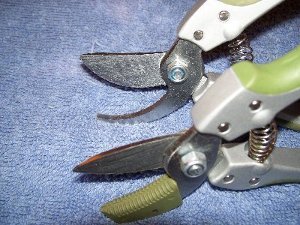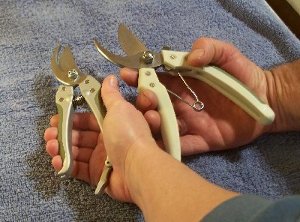Pruning Shears:
Choosing the Correct Tool for the Job
Pruners come in two types, anvil and bypass. Each has a specific design suited to a specific purpose.

Top: Bypass Pruning Shears
Bottom: Anvil Pruning Shears
Anvil Pruning Shears
Anvil Shears are designed for cutting through deadwood by using a crushing motion. Only one blade is sharpened, the other flattened, so that the branch is crushed against the flatter side while being cut with the knife edge. It is much like cutting a carrot against a cutting board, as opposed to trying to use a pair of scissors. Anvils are stronger than Bypass shears, but damage the branch they cut, so they should never be used to cut living plants.
Bypass Pruning Shears
Bypass shears are more like a pair of scissors. Both blades are sharpened, and one slides behind the other. These provide less leverage for cutting, and therefore are harder to use. However, when cutting living shrubbery, these are the better choice to prevent harm to your plants.
The Right Product for You
It is also important to get the right size pruners. Like a pair of gloves that don't fit right, gardening with the wrong tool can be more trouble than it's worth. Get pruners too big, and your hands will not comfortably fit around the handles. Get them too small, and you may find the skin at the base of your thumb pinched uncomfortably each time you use them.

Left: 7 inch Bypass Pruners
Right: 8 inch Bypass Pruners
Most pruners are about 8 inches long. These are an excellent choice for folks with average to large hands. However, those of us with smaller mitts are more comfortable with 7 inch pruners. They can be harder to find, but are well worth the hunt.
When choosing pruners, make sure the packaging allows you to hold the handles as you would be when using them. Ideally, you should be able to open and close the pruners to make sure the fit is right for you.
